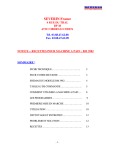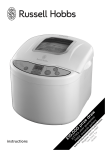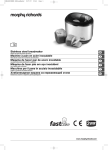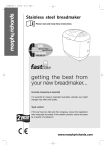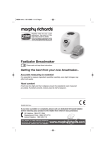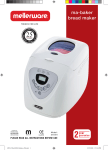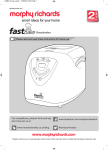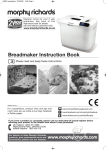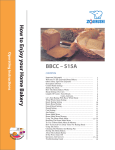Download Salton elite SCM015 Instruction manual
Transcript
INSTRUCTIONS AND WARRANTY MODEL NO. SFBM01 Salton Elite Food Collection Bread Maker Congratulations on purchasing our Salton Elite Food Collection Bread Maker. Each unit is manufactured to ensure safety and reliability. Before using this appliance for the first time, please read the instruction manual carefully and keep it for future reference. FEATURES OF THE SALTON ELITE BREADMAKER IMPORTANT SAFEGUARDS When using any electrical appliance, basic safety precautions should always be followed including the following: 1. Please read the instructions carefully before using the breadmaker. 2. Always ensure that the voltage on the rating label corresponds to the mains voltage in your home. 3. Incorrect operation and improper use can damage the breadmaker and cause injury to the user. 4. The breadmaker is intended for household use only. Commercial use invalids the warranty and the supplier cannot be held responsible for injury or damage caused when using the appliance for any other purpose than that intended. 5. Avoid any contact with moving parts. 6. This breadmaker is not intended for use by persons (including children) with reduced physical, sensory or mental capabilities, or lack of experience and knowledge, unless they have been given supervision or instruction concerning use of the appliance by a person responsible for their safety. 7. Children should be supervised to ensure that they do not play with the breadmaker. 8. Check the power cord and plug regularly for any damage. If the cord or the plug is damaged, the manufacturer or a qualified person must replace it in order to avoid an electrical hazard. 9. Do not use the breadmaker if it has been dropped or damaged in any way. In case of damage, take the unit in for examination and/or repair by an authorised service agent 10. To reduce the risk of electric shock, do not immerse or expose the motor assembly, plug or the power cord to water or any other liquid. 11. Never immerse the unit in water or any other liquid for cleaning purposes. 12. Remove the plug from the socket by gripping the plug. Do not pull on the cord to disconnect the breadmaker from the mains. Always unplug the unit when not in use, before cleaning or when adding or removing parts. 2 13. The use of accessory attachments that are not recommended or supplied by the manufacturer may result in injuries, fire or electric shock. 14. A short cord is provided to reduce the hazards resulting from becoming entangled in or tripping over a longer cord. 15. Do not let the cord hang over the edge of a table or counter. Ensure that the cord is not in a position where it can be pulled on inadvertently. 16. Do not allow the cord to touch hot surfaces and do not place on or near a hot gas or electric burner or in a heated oven. 17. Do not use the breadmaker on a gas or electric cooking top or over or near an open flame. 18. Don’t touch hot surfaces – use oven gloves. 19. Don’t touch internal surfaces till the breadmaker has cooled down fully. 20. Keep clear of the vents in the sides and back of the breadmaker and the top of the dispenser. 21. Don’t plug the breadmaker in till after you’ve loaded the loaf tin (with the ingredients), into it. 22. Leave a clear space of at least 5cm all round the breadmaker when in use. 23. Don’t use anything metal or sharp on the loaf tin or the paddles, to avoid scratching the non-stick surfaces. 24. Use of an extension cord with the breadmaker is not recommended. However, if it is necessary to use an extension lead, ensure that the lead is suited to the power consumption of the appliance to avoid overheating of the extension cord, appliance or plug point. Do not place the extension cord in a position where it can be pulled on by children or animals or tripped over. 25. This breadmaker is not suitable for outdoor use. Do not use this appliance for anything other than its intended use. 26. DO NOT carry the breadmaker by the power cord. 27. Do not leave the breadmaker unattended during use. Always unplug the unit when not in use or before cleaning. 28. Always operate the breadmaker on a smooth, even, stable surface. Do not place the unit on a hot surface. 29. Ensure that the switch is in the “Off” position after each use. 3 30. The manufacturer does not accept responsibility for any damage or injury caused by improper or incorrect use, or for repairs carried out by unauthorised personnel. 31. In case of technical problems, switch off the machine and do not attempt to repair it yourself. Return the breadmaker to an authorised service facility for examination, adjustment or repair. Always insist on the use of original spare parts. Failure to comply with the above mentioned pre-cautions and instructions, could affect the safe operation of this machine. PARTS DIAGRAM OPERATING INSTRUCTIONS 1. Pick a recipe. 2. Measure the ingredients into the loaf tin in the correct order-this is essential. 3. Put the loaf tin into the breadmaker and close the lid. 4. Use the menu Z button to choose a program- basic, French, wholewheat, cake, sweet, dough, jam, sandwich, gluten free, fastbake 1, fastbake 2, and speciality. 5. Use the colour button to choose the crust colour – light 4 , medium , dark . 6. Use the size button to choose the size – small i (500g), medium j (750g), large k (1kg). 7. Use the + and - buttons to set the timer (optional). 8. Press the start/stop button to start the program. 9. The display counts down, then, when it’s finished, it’ll beep. After the beep, the breadmaker will keep the bread warm for an hour, on the basic, French, wholewheat, sweet, sandwich, gluten free, fastbake 1, and fastbake 2 programs. Preparation 10. Place the breadmaker on a stable, level, heat-resistant surface. 11. Don’t plug it in yet. 12. Open the lid. 13. Grip the loaf tin handle and pull the loaf tin up and out of the breadmaker. 14. Fit the paddle to the shaft in the bottom of the loaf tin. 15. The top of the shaft and the hole in the paddle are flattened (D-shaped), so you’ll have to rotate the paddle to fit it on the shaft. 16. Measure the ingredients, and have them all to hand, ready to add to the loaf tin. 17. Set out a wire tray (for the bread), a heatproof placemat (for the loaf tin), and oven gloves (for your hands). Measuring the ingredients 18. It is important that ingredients are measured accurately. 19. For example – if you have 6 ingredients and each one only gets 1% out, the difference will be the same as adding an extra-heaped teaspoon of sugar to a cup of tea – not nice! – so: a) Use the same measuring spoons for all the ingredients b) Use the back of a knife to level all spoons for measurements given in spoons. c) Don’t use a measuring jug – electronic scales are much more accurate than looking at lines on a jug, so rather weigh water. d) 1 millilitre of water weights 1 gram, so we’ve shown the water in the recipes as grams (g), rather than millilitres (ml) e) If you still want to measure the water with a measuring jug, simply replace 5 the “g” with “ml” (millilitres), but the results may not be consistent. f) If you’re using a recipe from elsewhere, replacing millilitres (ml) of water with grams (g) will help with the accuracy and consistency. Adding the ingredients in order. 20. It’s important that you add the ingredients in the correct order: a) If the yeast gets wet, it may activate too early b) If it comes in contact with salt, it may not work properly c) We’ve numbered them, to make it easier to follow the recipes 21. First, add the liquid: a) It’s usually water, but it might include milk and/or eggs b) The water should be warm (20°C-25°C/68°F-77°F), but only warm, not hot or cold. c) Both hot and cold water will inhibit the yeast, don’t use milk if you’re using the timer, it’ll curdle before the program starts. 22. Add any sugar and salt required by the recipe. 23. Add any “wet” ingredients – honey, syrup, and molasses. 24. Add the dry ingredients – flour, dried milk, herbs, and spices. 25. Finally – add the dried yeast (or baking powder/baking soda). a) Lay it on top of the other ingredients b) don’t get it wet, or it’ll start working to soon Take extra care with the timer 26. If you’re using the timer, it’s even more important to make sure that the yeast/baking powder/baking soda and water/liquid are well separated. a) They’ll have all day to get together, while you’re not looking b) The yeast will activate, grow, and die before the program starts c) Your bread will be hard, dense, coarse, and about as edible as a house brick Nuts and raisins 27. You shouldn’t normally add nuts and raisins at the start, as they might upset the recipe. 28. They’re normally added later, during the second kneading. 6 29. The breadmaker will give a long beep to indicate they are needed. The beep comes about 22 minutes after the start of programs 1 (basic) and 5 (sweet), but 47 minutes after the start of program 3 (wholewheat), to allow for 30 minutes preheating. Loading the breadmaker 30. Clean any spillage off the outside of the loaf tin. a) Spillage inside the machine will burn on to the surfaces. b) Spillage on the element will reduce its life. 31. Lower the loaf tin into the breadmaker. 32. If it won’t sit on the drive, lift it out, turn the drive slightly (less than ¼ of a turn), and try again. 33. If you spill, take the loaf tin out and clean up the spillage. 34. Close the lid. Power up 35. Plug the breadmaker into the wall socket (switch the socket on, if it’s switch able). a) The breadmaker will beep b) The display shows 1P (program 1, with medium crust), then 3:20 (the program duration) Choose your program from the menu 36. Use the menu Z button to change the program number to the one you want – they are: 1) basic 2) French 3) wholewheat (no movement during the 30 minutes preheating phase) 4) cake 5) sweet 6) dough 7) jam 8) sandwich 9) gluten free 10) fastbake I 11) fastbake II 12) speciality. 37. The time will change as you cycle through the program numbers – ignore it for now. Crust colour 38. Use the crust color button to move the arrow on the bottom of the display to the crust color you want – the options are: light 7 (Display = L), medium (Display = P), dark (display = H). 39. The crust colour button only works with the basic, French, wholewheat, and sweet programs, sizes: I j k. 40. Use the size button to move the arrow on the top of the display to the size you want – the options are: small I (500g), medium j (750g), large k (1kg). 41. These sizes are approximate – think of them as small, medium, and large. 42. The size button only works with the basic, French, wholewheat, sweet, and sandwich programs. Program Buttons No. Name Colour Size Timer 1 Basic ² ² ² 2 French ² ² ² 3 Wholewheat ² ² ² 4 Cake 5 Sweet ² ² 6 Dough 7 Jam 8 Sandwich 9 Gluten Free 10 Fastbake I 11 Fastbake II 12 Speciality ² ² Using the timer 43. Using the timer is optional – if you don’t want to use it, jump to point 49. 44. You may use the timer to set the finishing time up to 13 hours ahead (including the recipe time). 45. The timer only works with the basic, French, wholewheat, and sweet programs. 8 46. Don’t use the timer with a recipe containing fresh milk, yoghurt, cheese, eggs, fruit, onions, or anything else that might go off if left for a few hours in a warm moist environment. 47. It’s a great convenience, and it’s really nice to come home to the smell of freshly cooked bread, but, like most things, there’s a downside: a) Leaving the ingredients together for an extended period will inevitably cause some interaction, especially on a hot or humid day b) The results probably won’t be quite as good as bread made right away c) The bread will still be nice, but it’ll be “good”, rather than “great” 48. Here’s how: a) Carry out the instructions up to point 42 (page 8) b) Don’t use fruit, or anything moist – you’ll speed up the interaction. c) If your recipe uses nuts or raisins, add them after the flour. d) Decide when you want your bread to be ready, e.g. 6 p.m. e) Check the time now, e.g. 7 a.m. f) Work out the difference between the two times, e.g. 11 hours g) Use the + and - buttons to change the time shown on the display from the program time to the time you’ve just worked out (e.g. 11 hours). h) Each press will decrease - or increase + the time displayed by 10 minutes i) You can’t reduce the time to less than the program time. j) The maximum time which can be shown on the display is 13 hours k) When you’ve set the time, go to point 49 (press start/stop) l) Go to work/shopping/whatever, and on your return, you’ll be welcomed home by the aroma of freshly baked bread 7 Starting the breadmaker 49. When you’re happy with the settings, press the start/stop button. a) The breadmaker will beep b) The timer colon (:) flashes, to let you know the program is operating c) The timer starts counting down, to show the amount of time left Is there nothing happening on program 3? – don’t worry 50. If you’re using the wholewheat program, you won’t hear any movement for about 30 minutes. 9 51. Don’t worry, nothing’s wrong – this program needs the time to preheat the ingredients to about 25°C. Nuts and raisins 52. If the recipe uses nuts, raisins, or the like, they should be added during the kneading process a) This affects only programs 1 (basic), 3 (wholewheat), and 5 (sweet) b) You’ll know when it’s kneading – you’ll hear the paddles whirring c) The new ingredients should be as dry as possible d) If you’re using fresh fruit or vegetables, dry them with kitchen towel. The breadmaker will beep 15 times when it wants them: e) Open the lid f) Sprinkle the nuts/raisins/etc. evenly over the dough g) Close the lid Have a look/give it a stir 53. Have a look at the dough (through the window) after about 30 minutes of kneading. 54. If you spot any unincorporated ingredients round the walls of the loaf tin, use a soft spatula to ease them away from the walls, and into the dough. 55. Work only round the walls of the loaf tin, to avoid the paddle, If you hit the paddle, you may dislodge it – having to stop, replace the paddle, and start again isn’t much fun, so try to avoid it. 56. If you discover you’ve made a mistake after starting, press the start/stop button, and hold it down for 2 seconds, to stop the breadmaker. 57. Sort out the problem, and then restart the breadmaker. 58. Don’t leave it too long. 59. If the program is substantially into the cycle before you stop it, the results will be affected. 60. In that case, you have to decide whether it’s best to: a) Let the program run, and put up with the result b) Stop the program, throw out the ingredients, and start from scratch 10 Finishing 61. When it’s done, the breadmaker beeps to let you know your bread is ready. 62. Press the START/STOP button, and hold it down for 2 seconds, to stop the breadmaker. 63. Remove the bread (point 70, below). Keeping warm 64. If you don’t press the START/STOP button, the element will cycle on and off, to keep the bread warm for an hour. 65. After the hour is up, it’ll beep 10 times, then power down. 66. Don’t leave the bread in the loaf tin after the keep warm hour is up. Removing the bread 67. As it cools, moisture in the bread evaporates, drying it out and firming it up. a) Leaving the bread in the loaf tin traps the moisture b) It can’t evaporate, so it soaks into the bread as it cools down c) This will eventually affect the flavour and texture d) The “keep warm” feature will avoid this, up to a point, but the sooner the bread is removed, the better 68. This is where you need the wire tray, the heatproof placemat, and the oven gloves (remember, protect both hands). 69. Check that you’ve pressed the start/stop button – the display will revert to program number and duration. 70. Unplug the breadmaker (switch the socket off first, if it’s switch able). 71. Hot air and steam will billow out when you open the lid – keep away from the area above the breadmaker. 72. Put on the oven gloves (both hands). 73. Open the lid (use the handles). 74. Grip the loaf tin handle and pull the loaf tin up and out of the breadmaker. 75. Turn the loaf tin upside down and shake it to release the bread. 76. Put the bread on the wire tray to cool. 77. Put the loaf tin on the heatproof placemat, and leave it to cool. 78. If the bread won’t come out, run a heatproof plastic or wooden spatula round the inside of the loaf tin – don’t use anything metal or sharp, to avoid scratching the 11 non-stick surface. 79. Check that the paddle is still in the loaf tin. 80. If the paddle has come off with the bread: a) use something blunt, to avoid scratching the non-stick surfaces of the paddle b) use something slim, to avoid digging a hole in the bread c) a wooden kebab, ice lolly, or cocktail stick will do nicely d) turn the bread upside down (with the oven gloves) e) gently ease the paddle out with the stick 81. For best results, let the bread sit for 20-30 minutes to firm up and dry out before cutting. 82. Cutting the bread while it’s still warm and moist may make it soggy. 83. On the other hand, if you’d rather tear a bit off, smother it in butter, and eat it hot, hold a bit of kitchen towel under your chin, to keep the drips off your clothes. 84. Don’t cut the bread till you’ve checked the paddles. 85. If the knife hits the paddles: a) You’ll scratch the non-stick surface b) You may damage the knife c) If you’re really unlucky, you may even cut yourself Continuous use 86. Before reusing the breadmaker, let it cool, and check the inside for crumbs and other debris. 87. If you try to use it while it’s hot, you’ll get an error message on the display. 88. Unplug it, remove the loaf tin, and let the breadmaker cool down fully before trying again. The programs basic For basic white bread, or recipes based on white bread dough. French This program makes French-type bread, with a lighter texture and crispier crust. Recipes suitable for this program don’t normally use butter (or margarine) or milk. French-type bread doesn’t keep very well, so it’s best eaten within hours of being made. 12 Wholewheat The heavier flour needs preheating for about 30 minutes before kneading. Wholewheat/ wholemeal loaves tend to be smaller and denser. They don’t work very well with the timer. Cake This program is for cake and batter recipes, rather than dough, generally using baking powder or baking soda as the raising agent, rather than yeast. Sweet This program is used for sweeter bread recipes, often containing fruit. Don’t put the fruit in till the breadmaker beeps, or the fruit may be mashed, and the bread too moist. Dough This program uses the breadmaker as a mixing/kneading machine, to save your labour. You must remove the finished dough as soon as the program has finished, or it will deteriorate. Punch it back, cover, and let it rest for ten minutes or so before cutting/shaping. Jam 1. This program preheats the ingredients, and then boils them. 2. Allow plenty of room for the jam to expand when boiling. If jam boils over into the inside of the breadmaker, it will be very, very difficult to clean. 3. If it does boil over, press the START/STOP button, unplug the breadmaker, let it cool down, and clean it out before it sets. Caution: Don’t mess with hot jam – it retains its heat for a long time and it sticks like glue. If it gets on to your skin it won’t let go until it’s given you a nasty burn. Sandwich This program provides a loaf with a loose texture and a thin crust, ideal for making sandwiches. Gluten free Gluten free bread uses other substances to give the dough elasticity and bounce. Gluten free loaves tend to be denser and coarser than bread made with strong flour. 13 Fastbake I and II There are variations on the basic program, with reduced kneading, rising, and baking times, as they cut the program times to 55 and 80 minutes respectively, because of this, your bread will be smaller, denser, and coarser than normal, and any additional ingredients (raisins, nuts, etc.) may be mashed, or unevenly distributed. Speciality This program is specially designed for the malt loaf recipe. Ingredients flour The type of flour used is important. Use bread flour. These “bread” flours contain more gluten than ordinary baking flour. Gluten is the protein that gives the bread its structure and texture. It retains the carbon dioxide produced by the yeast, putting the elasticity, the bounce, into the dough. Other bread flours These include brown, wholemeal, and whole wheat (nutty wheat) bread making flours. These provide an excellent source of dietary fibre, but contain lower levels of gluten than strong white flour. This means that brown loaves tend to be smaller and denser than white loaves. Generally speaking, if you substitute white bread flour for half of the brown flour in the recipe, you can make bread with a “brown bread” flavour and a “white bread” texture. Yeast 1. Yeast is a living organism. Given moisture, food, and warmth, the yeast will grow and release carbon dioxide gas. The carbon dioxide forms bubbles, which are trapped in the dough, making it rise. 2. Of the various types of yeast available, we recommend using “dried active yeast”, also known as “dry active yeast”, and “instant yeast” or “easy blend dried yeast”. These are usually sold in 7 gram sachets and don’t have to be dissolved in water first. 3. If you don’t use all the yeast in a sachet, throw it away, don’t save it – it’ll go stale. 14 4. Don’t use fresh or tinned yeast – they won’t work properly with your breadmaker. 5. Check the “best before” date on the sachet of yeast – if it’s approaching its “best before” date, don’t take any chances – throw it out and buy some more. 6. You may also see “fast action’ or “bread machine” yeast – really potent yeasts that can make dough rise up to 50% faster. If you want to use these, you’ll need to do a bit of experimenting to get the best results. You could start off by trying them with the fastbake programs. Liquid 1. The liquid ingredient is normally water or milk, or a mixture of the two.\ 2. Water makes a crispier crust. Milk gives a softer crust with a velvety texture. 3. The liquid should be warm, not hot or cold. Both hot and cold water will inhibit the yeast. 4. Some recipes call for hand-hot water (that’s 35°C-50°C/95°F-122°F), to speed up the process. Only the fast yeasts can handle this temperature. 5. Don’t use milk with the timer; it might curdle before the bread-making process starts. Butter/fat These make the dough tenderer and enhance the flavour, giving the finished loaf a richer quality. They help to retain moisture, making the bread keep fresh longer. Margarine or olive oil can be used instead of butter, but they are less effective. Low fat spread Don’t use low fat spread. Never mind what the manufacturer says, it’s designed for spreading, not for cooking. It’s “low fat”, where the recipe needs “fat”. Sugar 1. Sugar activates and feeds the yeast, allowing it to grow. It adds flavour and texture, and helps with browning the crust. Many sachet yeasts do not need sugar to activate. 2. Honey, syrup, or molasses may be used instead of sugar, provided the liquid ingredient is adjusted to compensate. 15 3. Don’t use artificial sweeteners. None of these will feed the yeast, some of them will kill it. Salt Salt helps to control the growth of the yeast. Without salt, the bread could rise too much, and then collapse. It also adds to the flavour. Keep it away from the yeast until the last minute, or it might inhibit it. Eggs Eggs will make your bread richer and more nutritious, add colour, and help with the structure and texture. Eggs count as part of the liquid ingredient of the bread, so adjust the other liquid ingredients if you are adding egg(s). Otherwise the dough may be too wet to rise properly. Herbs and spices 1. These can be added at the beginning, along with the main ingredients. 2. Dried herbs and spices like cinnamon, ginger, oregano, parsley, and basil will add flavour and interest. Use small quantities (a teaspoon) to avoid overpowering the flavour of the bread. 3. Fresh herbs, like garlic and chives may contain enough liquid to upset the balance of the recipe, so adjust the liquid content. Nuts and raisins 1. Dried fruit and nuts should be chopped finely; cheese should be grated; chocolate chips should definitely be chips, not lumps. Don’t add more than the recipe requires, otherwise the bread may not rise properly. 2. Be careful with fresh fruit and nuts. These contain liquids (juices and oils), so you may need to adjust the main liquid ingredient to compensate. 3. Add these only when the breadmaker beeps, early in the program. Storing bread 1. Commercial bread contains all sorts of additives (chlorine, chalk, coal-tar dye, sorbitol, soya, etc.). 16 2. Your bread won’t have any of these, so it won’t keep like commercial bread, and it won’t look like commercial bread. On the plus side, it won’t taste like commercial bread either – it’ll taste like bread should. 3. It’s best eaten fresh, but you can store it for a couple of days at room temperature, in a polythene bag with the air squeezed out. 4. To freeze bread, let it cool, put it in a polythene bag, suck all the air from the bag, then seal it. 5. Don’t put bread in the fridge. Bread going stale is due to chemical reactions. Most chemical reactions have an ideal temperature range, at which they work best. Guess what? – the chemical reactions involved in bread going stale work best at fridge temperatures. 6. Remember – freezing bread is OK – just don’t stick it in the fridge. Kitchen temperature Kitchen temperature can affect the outcome of your baking. The breadmaker works best in a kitchen with a temperature between 15°C and 34°C (59°F and 93°F). Power cuts 1. If you suffer from a power cut lasting less than 7 minutes, the breadmaker will carry on when power is restored, and the program time will be extended by the duration of the power cut. 2. If the power cut is more than 7 minutes, the program will fail – unplug the breadmaker, let it cool down, then empty the loaf tin, dispose of the ingredients, clean it, and start again. 3. This also works if you unplug the breadmaker or switch it off accidentally. , Make sure you remove the paddles before you dispose of the ingredients. Error messages 1. If the breadmaker is too hot, the display will show an error message – an odd set of letters and/or numbers. 2. If this happens, press the start/stop button for 2 seconds, remove the loaf tin, and let the breadmaker reach room temperature before trying again. 3. If this doesn’t work, then the problem isn’t overheating, it’s probably broken. 17 Recipes 1. Many external factors affect the taste and texture of your bread (e.g. yeast type, flour type, sugar type, kitchen temperature, even air pressure and height above sea level). 2. The recipes supplied have been designed specially for this breadmaker. 3. If you want to experiment, use the recipes as a guide, but vary the ingredients, vary the quantities, taste the results. Keep notes, write down what changes you make, and you’ll build up a range of recipes which suit your taste. Keep notes of the not-so-successful ones too, so you know what not to do next time. 4. You’ll find it’s best to change only one ingredient at a time – if you change more than one, you won’t know which one was responsible for the effect you got. 5. If you already have bread recipes, or find recipes in other publications, compare them with the recipes given here, to find out which program to try first, then experiment till the results match your desires. 6. Be careful with quantities when using other recipes. For the first trial, don’t fill the loaf tin above quarter full, certainly not as much as a third full. If you overfill it, the rising bread may push the lid off. That’s on a good day. On a bad day, it’ll spill over the side, burn on to the element and clog the drive. Using the recipes 1. Tablespoons (tbsp) are 15ml, teaspoons (tsp) are 5ml. 2. Spoons should be level, not heaped. 3. Measure everything with the same set of measuring spoons. 4. Weighing water (1g=1ml) is more accurate than using a measuring jug. 5. Dried milk should be dried skimmed milk. 6. Use new, unopened, sachets of dried yeast – check the “best before” dates. 7. If you don’t use all the yeast in a sachet, throw it away, don’t save it – it’ll go stale. 8. Use flour marketed as “strong flour” or “bread-making flour” – ordinary flour won’t work. 9. Don’t open the lid unless you absolutely have to – then close it again. 10. The best bread knife has a toothed blade a bit like a hacksaw blade – use it to saw the bread, without much pressure, so the bread doesn’t become distorted. , 18 Put the ingredients into the loaf tin in the correct order – we’ve numbered them, to make it easier to follow the recipes. Troubleshooting – what to do if: the bread collapses 1. The dough may have been too moist. Reduce the recipe liquid by 2 tbsp. If tinned fruit was used, it may not have been properly drained. 2. Leaving the bread in the loaf tin while it cools can cause moisture released in the baking process to soak back into the bread. 3. The flour may have been too coarsely ground. Try using finer flour. The bread doesn’t rise 1. One or more ingredients were added in the wrong quantities – accuracy is essential 2. The yeast is stale – check the “best before” date – use a fresh, unopened sachet every time. The core of the bread is too moist 1. The dough may have been too moist, see above. 2. The flour may have been too heavy. This problem can occur with rye, bran and whole meal flours. Reduce the amount of heavy flour and replace with white flour. The bread has swollen too much 1. You may have used too much yeast, try reducing it slightly. 2. Too much sugar can cause the yeast to work too fast, and the bread to rise too much. Try reducing the amount of sugar. If you add sweet/sugary ingredients such as dried fruit, honey or molasses, reduce the amount of sugar to compensate. 3. You might try reducing the recipe liquid by 2 tbsp, as this will slow the action of the yeast. 4. Use coarser flour. Less yeast is needed with fine flour than with the same type of flour ground coarsely. The bread tastes bland Try increasing the amount of salt by up to ¼ of a teaspoon. 19 RECIPES Loaf size (500g) (750g) (1kg) 1 water 190g 260g 360g 2 olive oil 1 tbsp 1 tbsp + 1 tsp 2 tbsp 3 salt 1 tsp 1½ tsp 2 tsp 4 sugar 1 tbsp 1 tbsp + 1 tsp 2 tbsp 5 dried milk powder 1 tbsp 1½ tbsp 2 tbsp 6 white bread flour 350g 500g 650g 7 yeast 1½ tsp 1¼ tsp 2 tsp White bread Setting: Basic French Setting: French 1 water 200g 300g 400g 2 salt 1 tsp 1½ tsp 2 tsp 3 white bread flour 360g 545g 725g 4 yeast 1 tsp 1½ tsp 1 water 200g 300g 400g 2 olive oil 1 tbsp 1 tbsp 2 tbsp 3 salt ¾ tsp 1¼ tsp 2 tsp 4 sugar 2 tsp 1 tbsp 1½ tbsp 5 dried milk powder 1 tbsp 1½ tbsp 2 tbsp 6 whole wheat flour/ 150g 220g 300g 7 white bread flour 150g 220g 300g 8 yeast ½ tsp ¾ tsp 1 tsp 1 sachet Whole-wheat Bread Setting: Whole wheat brown bread flour/ nutty wheat 20 Mixed fruit cake (750g) Setting: Cake 1 lemon juice 1 tsp 2 egg-small 2 3 vanilla extract ¼ tsp 4 butter, melted - (must be melted) 50g 5 mixed fruit (soaked) 175g 6 white bread flour 250g 7 sugar 150g 8 cinnamon ¼ tsp 9 nutmeg ¼ tsp 10 baking powder 2 tsp 11 brandy (optional) a dash If, during the first 30 minutes of the program, ingredients stick to the walls of the loaf tin, give the dough a little careful “help” with a soft spatula to incorporate them in the loaf. Chocolate bread This is not a cake – it’s nice just buttered, or toasted and buttered. Setting: Sweet Loaf size (500g) (750g) (1kg) 1. Milk 200g 300g 400g 2. Olive oil 1 tbsp 1½ tbsp 2 tbsp 3. Salt 1 tsp 1½ tsp 2 tsp 4. Sugar 2 tbsp 3 tbsp 4 tbsp 5. Vanilla extract ½ tsp ¾ tsp 1 tsp 6. Whole meal flour 300g 450g 600g 7. Cocoa powder 25g 40g 50g 8. Yeast 1½ tsp 2 tsp 1 sachet 5 tbsp 3 tbsp 9. Chopped hazelnuts 7 tbsp 21 Dough (pizza) (750g) Setting: Dough 1 Water 250g 2 Olive oil 1 tbsp 3 Salt 1 tsp 4 Sugar 2 tbsp 5 Strong white flour 400g 6 Yeast 1tsp 7 Mixed herbs 1 tsp Remove from the loaf tin, work into a ball on a floured surface, then leave to rest under a clean cloth for about 15 minutes. If the dough is sticky, add a little extra flour and it’ll form a nice ball as you work it in. Add your preferred toppings, then bake in a preheated oven at 200°C/400°F/Gas mark 6 for 15 to 20 minutes, till the crust is golden brown and the toppings are fully cooked. Jam (strawberry compote) Setting: Jam 1. 1 strawberries 500g 2. Lemon juice 2 tbsp 3. Sugar 100g 4. Vanilla extract ¼ tsp 5. Cinnamon ¼ tsp 6. Optional liqueur dash Mash all the ingredients together, and then add to the loaf tin. Select the JAM setting. 22 Loaf size (500g) (750g) (1kg) Sandwich Setting: Sandwich 1. Milk 250g 300g 400g 2. Olive oil 1 tbsp 1½ tbsp 2 tbsp 3. Salt 1 tsp 1½ tsp 2 tsp 4. Sugar 1½ tbsp 2 tbsp 3 tbsp 5. Strong white flour 370g 450g 600g 6. Yeast 1½ tsp 2 tsp 1 sachet Gluten free Setting: Gluten Free 1. Water 350g 2. Olive oil 1½ tbsp 3. Salt ½ tsp 4 4. Sugar 1 tbsp 5. Gluten free mix 400g 6. Yeast 1 tsp If, during the first 30 minutes of the program, ingredients stick to the walls of the loaf tin, give the dough a little careful “help” with a soft spatula to incorporate them in the loaf. If the loaf sticks to the loaf tin, gently free it with a wooden spatula. Fastbake 1 1. Water 300g 2. Olive oil 1 tbsp + 1 tsp 3. Salt 1½ tsp 4. Sugar 1 tbsp + 1 tsp 5. White Bread flour 470g 6. Dried milk powder 1 tbsp + 1 tsp 7. Yeast 2 tsp 23 Loaf size (500g) (750g) 1kg) Fastbake 2 Setting: Fastbake 2 1 water 400g 2 olive oil 2 tbsp 3 salt 2 tsp 4 sugar 2 tbsp 5 strong white flour 630g 6 dried milk powder 2 tbsp 7 yeast 1sachet Malt loaf Setting: Speciality 1 water 270g 2 olive oil 1 tbsp 3 salt 1 tsp 4 dried milk powder 1 tbsp 5 white bread flour 450g 6 yeast 1½ tsp 7 sultanas 200g 8 honey 1 tbsp 9 malt extract 2 tbsp 10 black treacle 1½ tbsp Traditional South African Vetkoek Setting: Dough Ingredients 1kg Lukewarm water Vegetable oil Dried milk powder Baking powder Salt Cake flour Dried active yeast 300ml 30 ml 3 tbsp 1 tsp 2 tsp 560 g 2 tsp 24 Method 1. Weigh the flower and set aside. 2. Measure the liquid into a measuring jug. Have all other ingredients at hand. 3. Starting always with the liquid, add ingredients in the tin in the order set out in the recipe. As a general rule, always add the water and any other moist ingredients first, followed by items such as oil, sugar, salt etc. Next add in the flower, which will create a barrier between the wet ingredients and the yeast. Lastly add the yeast on top, as well as the baking powder. There is no need to re-activate dried sachet yeast in water first, as it is ready to use. 4. Set to the program directed in the recipe, e.g. “dough”. 5. Press start 6. When the cycle has finished, the machine will beep, and the dough has to be removed immediately. 7. Place the dough on a clean flowered work surface, and break off hand palm sized pieces. Flatten the pieces and lightly cover with flower. 8. Deep fry carefully in pre-heated canola or sunflower oil until golden brown. Traditional South African Pap Setting: Cake Ingredients 1kg Water 6 cups Butter (optional) 2 tbsp Mielie Meal 3 cups Salt 3 tsp Method 1. Add all ingredients in above order. 2. Stir all ingredients with a spoon ensuring the corners of the bread pan are covered. 3. Place bread pan inside the bread maker as per instructions. 4. Select setting number 9 (cake). 5. Press Start 25 Chakalaka Bread Setting: Basic or White Ingredients 950g Water 285ml Chakalaka 100ml Canola oil / butter 1 tbsp Cremora powder 2 tbsp Sugar 2 tsp Salt 2 tsp Cake flour 500g Dried active yeast 4 tsp Method 1. Weigh the flour out and set aside. 2. Next measure (or weigh for great accuracy) the water in a measuring jug. Mix the chakalaka into the water. Have all other ingredients at hand. 3. Starting always with the liquid, add the ingredients into the tin in the order set out in the recipe. As a general rule always add water and any moist ingredients first, followed by items such as oil, sugar, salt etc. Next add in flour which will create a barrier between the wet ingredients and the yeast (particularly important if using the timer delay setting). Lastly add the sachet yeast on top. There is no need to re-activate dried sachet yeast in water first, as it is ready to use. 4. Set to the program directed in the recipe to the ‘Basic’ or ’White’ setting. 5. Set size of loaf on 1kg. 6. Set desired crust colour, light, medium or dark 7. Press start. 8. When the cycle has finished, the machine will beep and the bread will be kept warm for 1 hour. For best results, remove from tin immediately and allow to cool on a wire rack for 20 - 30 minutes before slicing. 26 Handy Hint: Create your own chakalaka butter by blending 50g butter and 25g chakalaka for an extra boost of flavour. Spread on as you would with normal butter. You can also determine the bite of your bread by using mild, medium, hot or extra hot chakalaka. Spinach & Feta Bread Setting: basic or White Ingredients 950g Water 285ml Crumbed Feta 100g Finely chopped spinach 4 tbsp Canola oil / butter 1 tbsp Cheese powder 2 tbsp Sugar 2 tsp Salt 2 tsp Cake flour 500g Dried active yeast 4 tsp Method 1. Weigh the flour out and set aside. 2. Next measure (or weigh for great accuracy) the water in a measuring jug. Mix the spinach and feta into the water. Have all other ingredients at hand. 3. Starting always with the liquid, add the ingredients into the tin in the order set out in the recipe. As a general rule always add water and any moist ingredients first, followed by items such as oil, sugar, salt etc. Next add the flour which will create a barrier between the wet ingredients and the yeast (particularly important if using the timer delay setting). Lastly add the sachet yeast on top. There is no need to re-activate dried sachet yeast in water first, as it is ready to use. 4. Set to the program directed in the recipe to the ‘Basic’ or ’White’ setting. 5. Set size of loaf on 1kg. 6. Set desired crust colour, light, medium or dark 7. Press start. 27 8. When the cycle has finished, the machine will beep and the bread will be kept warm for 1 hour. For best results, remove from tin immediately and allow to cool on a wire rack for 20 - 30 minutes before slicing. Handy Hint: Create your own feta butter by blending 50g butter and 25g crumbed feta for an extra boost of cheese flavour. Spread on as you would with normal butter. Crumbed feta can also be strewn on top of the bread just as it finished baking. Close the lid for 10 minutes with the cheese on top in order for it to melt. Whoever gets this cheesy crust is the lucky one! Corn Bread Setting: Basic or White Ingredients 950g Water 285ml Corn kernels 100g Canola oil / butter 1 tbsp Cremora powder 2 tbsp Creamed corn 2 tbsp Sugar 2 tsp Salt 2 tsp Cake flour 570g Dried active yeast 4 tsp Method 1. Weigh the flour out and set aside. 2. Next measure (or weigh for great accuracy) the water in a measuring jug. Mix the corn kernels into the water. Have all other ingredients at hand. 3. Starting always with the liquid, add the ingredients into the tin in the order set out in the recipe. As a general rule always add water and any moist ingredients first, followed by items such as oil, sugar, salt etc. Next add in flour which will create a barrier between the wet ingredients and the yeast (particularly important if using the timer delay setting). 28 Lastly add the sachet yeast on top. There is no need to re-activate dried sachet yeast in water first, as it is ready to use. 4. Set to the program directed in the recipe, e.g. ‘Basic’ or ’French’. 5. Set size of loaf to 1kg. 6. Set desired crust colour, light, medium or dark 7. Press start. 8. When the cycle has finished, the machine will beep and the bread will be kept warm for 1 hour. For best results, remove from tin immediately and allow to cool on a wire rack for 20 - 30 minutes before slicing. Handy Hint: Tinned corn can be used, but if you have corn on the cob available, carefully slice the kernels off with a knife. You will definitely taste the difference in freshness! Brie or camembert bread Setting: Basic or White Ingredients 950g Water 285ml Finely diced brie or camembert 100g Olive oil / butter 1 tbsp Dried milk powder 2 tbsp Cheese powder 2 tbsp Sugar 2 tsp Salt 2 tsp Cake flour 500g Dried active yeast 4 tsp Method 1. Weigh the flour out and set aside. 2. Next measure (or weigh for great accuracy) the water in a measuring jug. Mix the brie or camembert with the water. Have all other ingredients at hand. 29 3. Starting always with the liquid, add the ingredients into the tin in the order set out in the recipe. As a general rule always add water and any moist ingredients first, followed by items such as oil, sugar, salt etc. Next add in flour which will create a barrier between the wet ingredients and the yeast (particularly important if using the timer delay setting). Lastly add the sachet yeast on top. There is no need to re-activate dried sachet yeast in water first, as it is ready to use. 4. Set to the program directed in the recipe, e.g. ‘Basic’ or ’White’. 5. Set size of loaf on 1kg. 6. Set desired crust colour, light, medium or dark 7. Press start. 8. When the cycle has finished, the machine will beep and the bread will be kept warm for 1 hour. For best results, remove from tin immediately and allow to cool on a wire rack for 20 - 30 minutes before slicing. As an extra: Thin slices of brie or camembert can also be strewn on top of the bread just as it finished baking. Close the lid for 10 minutes with the cheese on top in order for it to melt. The crust will be a special treat for a special person! CLEANING AND MAINTENANCE • This breadmaker is for household use only and is not user-serviceable. • Always remember to unplug the unit from the electrical outlet when not in use and before cleaning. Ensure that the bread maker is switched off. • Open the lid, and let it cool down before cleaning. • If the paddle has stuck to its shaft, fill the loaf tin with warm water. This should soften any dough residues and allow the paddle to be removed. Don’t leave it to soak. • If the inside of the paddle gets clogged with flour, soak it in warm water, then remove the flour with a wooden cocktail stick. • It is much easier to clean the accessories directly after they have been used. Wash them in warm, soapy water, rinse and dry well. The baking pan is also dishwasher safe. 30 • You may wash the loaf tin and paddles in a dishwasher. Please note that the inside of the dishwasher may affect the surface finishes. If you do, then you must put the paddle, on its own, in a compartment of the cutlery basket. • Wipe all other surfaces, internal and external, with a damp cloth. Use a little washing-up liquid if necessary, but be sure to clean it all off, otherwise it might taint the next lot of bread. • Do not use bleach or other abrasive substance or solvents to clean your breadmaker as it can be damaging to the finish. • Do not immerse the body of the bread maker in water or any other liquid, or hold it under a running tap to clean. • To remove stubborn spots/marks, wipe the surfaces with a cloth slightly dampened in soapy water or mild non-abrasive cleaner. • Make sure everything is dry before re-using the bread maker or storing it away. STORING THE APPLIANCE • Unplug the unit from the wall outlet and clean all the parts as instructed above. Ensure that all parts are dry before storing. • Store the appliance in its box or in a clean, dry place. • Never store the appliance while it is still wet or dirty. • Never wrap the power cord around the appliance. SERVICING THE APPLIANCE There are no user serviceable parts in this appliance. If the unit is not operating correctly, please check the following: • You have followed the instructions correctly • That the unit has been wired correctly and that the wall socket is switched on. • That the mains power supply is ON. • That the plug is firmly in the mains socket. If the appliance still does not work after checking the above: - Consult the retailer for possible repair or replacement. If the retailer fails to resolve the problem and you need to return the appliance, make sure that: • The unit is packed carefully back into its original packaging. 31 • Proof of purchase is attached. • A reason is provided for why it is being returned. If the supply cord is damaged, it must be replaced by the manufacturer or an authorised service agent, in order to avoid any hazard. If service becomes necessary within the warranty period, the appliance should be returned to an approved Tedelex Trading (Pty) Ltd service centre. Servicing outside the warranty period is still available, but will, however, be chargeable. CHANGING THE PLUG Should the need arise to change the fitted plug, follow the instructions below. This unit is designed to operate on 230V-240V current only. Connecting to other power sources may damage the appliance. Connect a three-pin plug as follows: The wires in this mains lead are coloured in accordance with the following code: Green/Yellow = Earth Blue = Neutral Brown = Live 32 PLEASE AFFIX YOUR PROOF OF PURCHASE/RECEIPT HERE IN THE EVENT OF A CLAIM UNDER WARRANTY THIS RECEIPT MUST BE PRODUCED. WARRANTY 1. Tedelex Trading (Pty) Limited (“Tedelex”) warrants to the original purchaser of this product (“the customer”) that this product will be free of defects in quality and workmanship which under normal personal, family or household use and purpose may manifest within a period of 1 (one) year from the date of purchase (“warranty period”). 2. Where the customer has purchased a product and it breaks, is defective or does not work properly for the intended purpose, the customer must notify the supplier from whom the customer bought the product (“the supplier”) thereof within the warranty period. Any claim in terms of this warranty must be supported by a proof of purchase. If proof of purchase is not available, then repair, and/or service charges may be payable by the customer to the supplier. 3. The faulty product must be taken to the supplier's service centre to exercise the warranty. 4. The supplier will refund, repair or exchange the product in terms of this warranty subject to legislative requirements. This warranty shall be valid only where the customer has not broken the product himself, or used the product for something that it is not supposed to be used for. The warranty does not include and will not be construed to cover products damaged as a result of disaster, misuse, tamper, abuse or any unauthorised modification or repair of the product. 5. This warranty will extend only to the product provided at the date of the purchase and not to any expendables attached or installed by the customer. 6. If the customer requests that the supplier repairs the product and the product breaks or fails to work properly within 3 (three) months of the repair and not as a result of misuse, tampering or modification by or on behalf of the customer, then the supplier may replace the product or pay a refund to the customer. 7. The customer may be responsible for certain costs where products returned are not in the original packaging, or if the packaging is damaged. This will be deducted from any refund paid to the customer. TEDELEX TRADING (PTY) LTD (JOHANNESBURG) JOHANNESBURG TEL NO. (011) 490-9600 CAPE TOWN TEL NO. (021) 535-0600 DURBAN TEL NO. (031) 792-6000 www.amap.co.za 33



































